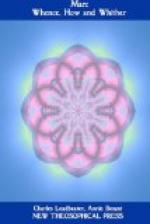The distance from the single-celled amoeba to hydra is vast, probably really greater than that between any other successive terms of our series. It may therefore be useful to consider one or two intermediate forms and the parallel embryonic stages of higher animals, and to see how the higher many-celled animal originates from the unicellular stage.
The amoeba is an illustration of a great kingdom of similar, practically unicellular forms, which have played no unimportant part in the geological history of the globe. These are the protozoa. They include, first of all, the foraminifera, which usually have shells composed of carbonate of lime. These shells, settling to the bottom of the ocean, have accumulated in vast beds, and when compacted and raised above the surface, form chalk, limestone, or marble, according to the degree and mode of their hardening.
The protozoa include also the flagellata, a great, very poorly defined mass of forms occupying the boundary between the plant and animal kingdoms. They are usually unicellular, and their protoplasm is surrounded by a thin, structureless membrane. This prevents their putting out pseudopodia as organs of motion. Instead of these they have at one end of the ovoid or pear-shaped body a long, whiplash-like process or thread, a flagellum, and by swinging this they propel themselves through the water. These flagellata seem to have a rather marked tendency to form colonies. The first individual gives rise to others by division. But the division is not complete; the new individuals remain connected by the undivided rear end of the body. And such a colony may come to contain a large number of individuals.
[Illustration: 2. Magosphaera planula. Lang, from Haeckel.]
Such a colony is represented by magosphaera. This is a microscopic globular form, discovered by Professor Haeckel on the coast of Norway. It consists of a large number of conical or pear-shaped individual cells, whose apices are turned toward the centre of the sphere. The cells are cemented together by a mucilaginous substance. Around their exposed larger ends, which form the surface of the sphere, are rows of flagella, by whose united action the colony rolls through the water. After a time each individual absorbs its flagella, the colony is broken up, the different individuals settle to the bottom, and each gives rise by division to a new colony. This group of cells may be considered as a colony or as an individual. Each term is defensible.
Volvox is also a spheroidal organism, composed often of a very large number of flagellated cells. But it differs from magosphaera in certain important respects. In the first place its cells have chlorophyl, the green coloring matter of plants. It lives therefore on unorganized fluid nourishment, carbon dioxide, nitrates, etc. It is a plant. But certain characteristics render it probable that




